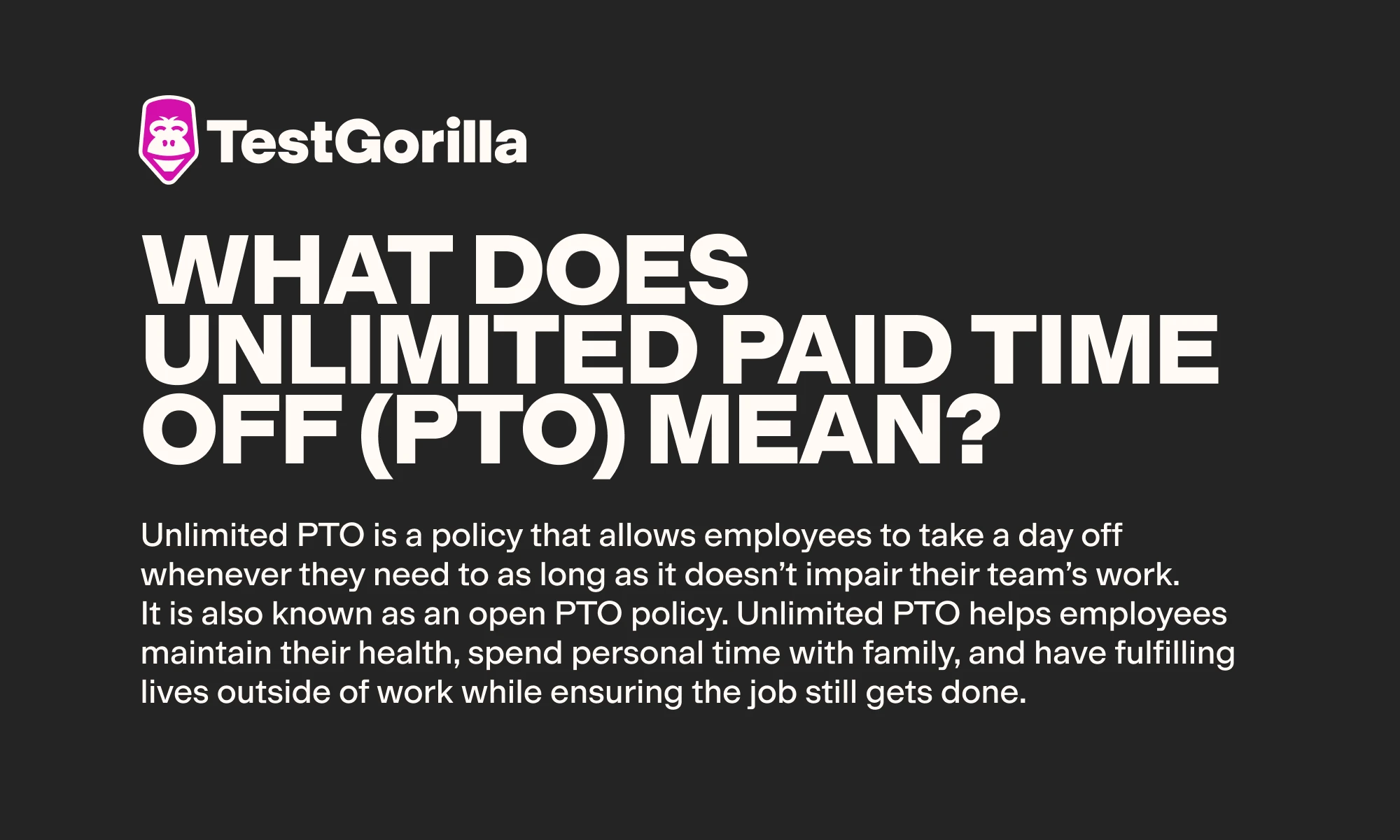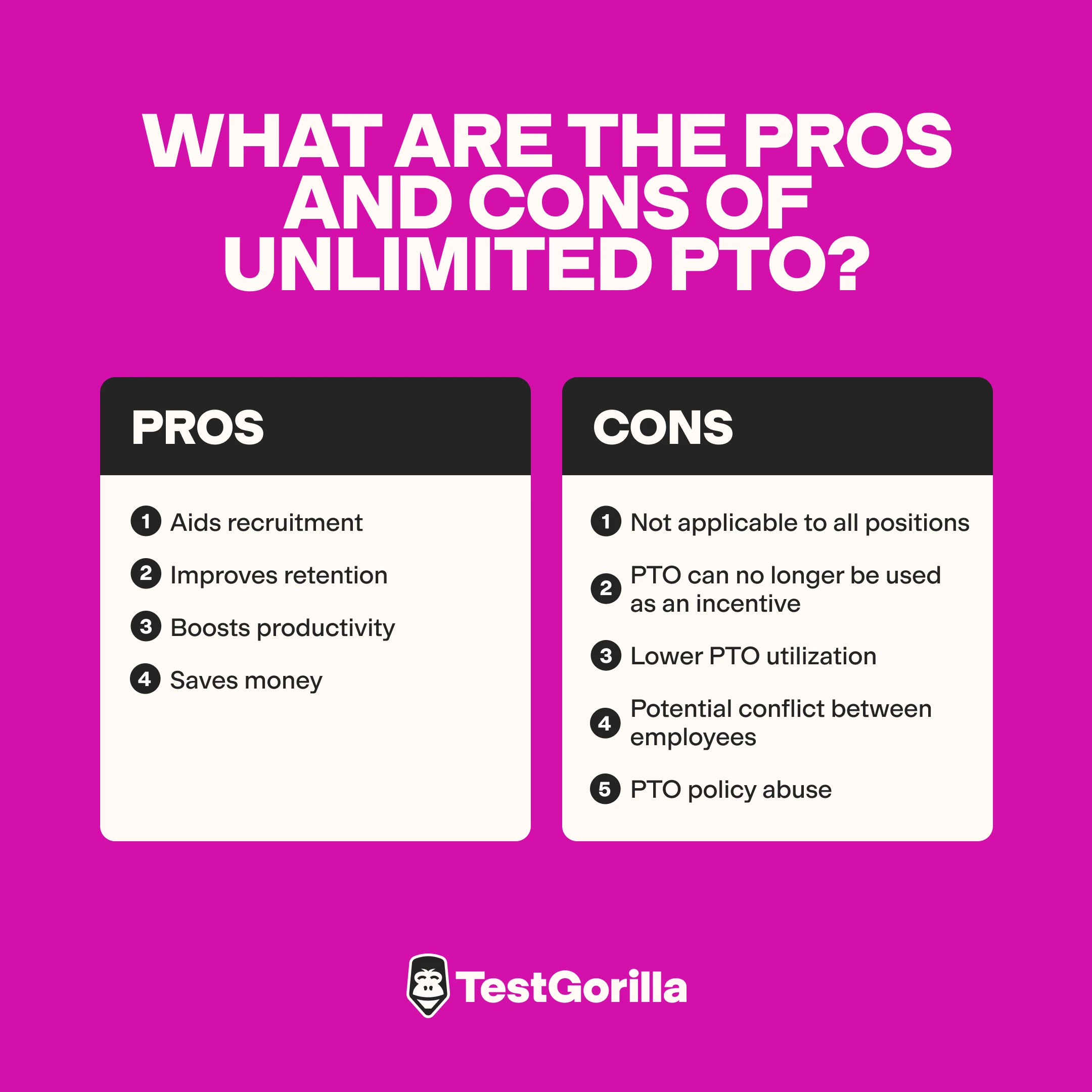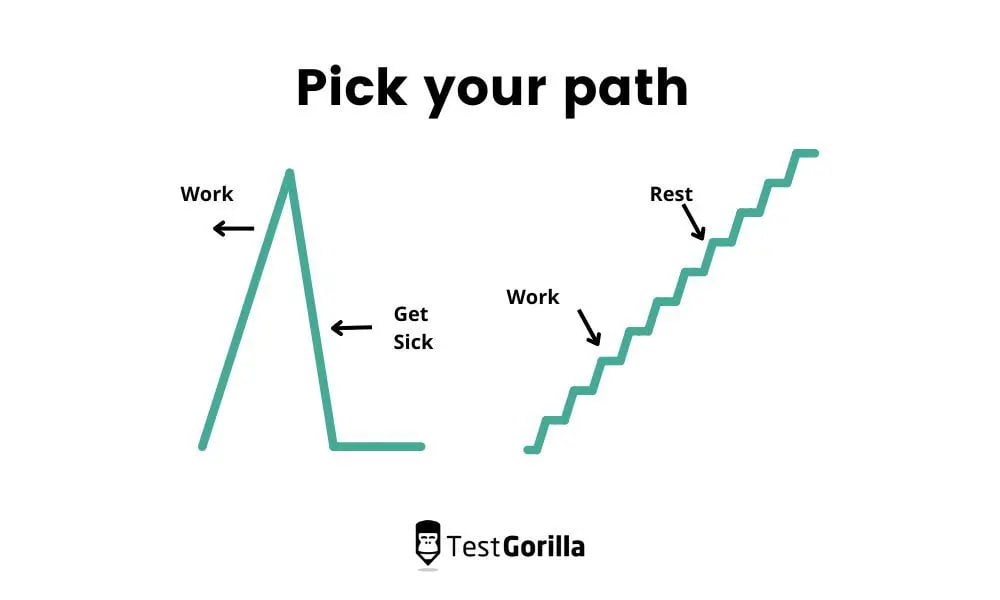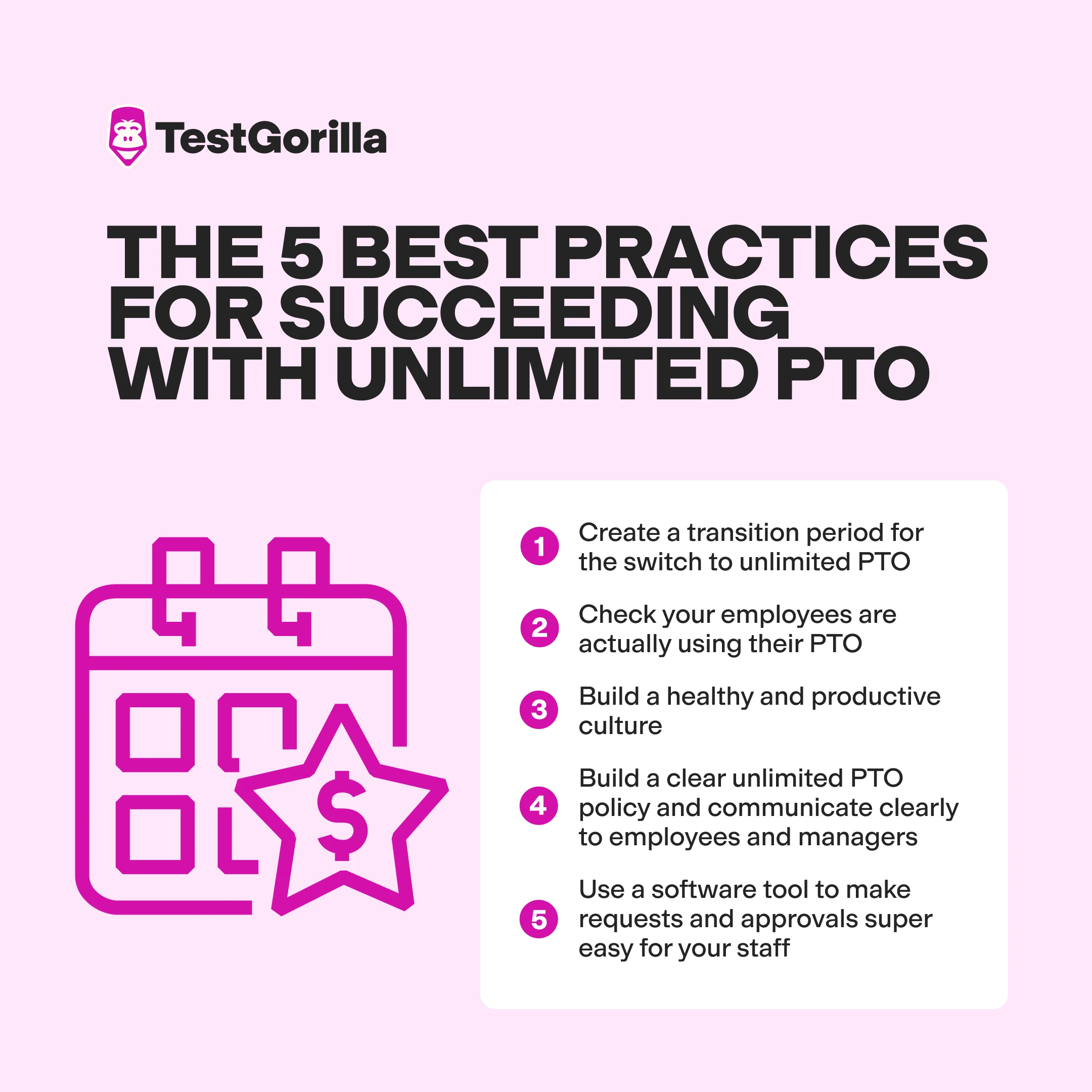Hire for the right fit with skills assessment software
It’s a struggle to compete for top talent. Skilled workers choose companies for the benefits and work culture, leaving old-fashioned firms in the dust.
But you can safeguard your talent pipeline and build competitive teams with unlimited paid time off (PTO) – as long as you do it right. According to Comparably, more than 60% of Asana employees rate unlimited PTO as their most important benefit.
So, how do you set your unlimited PTO up for success? Use our guide to offer unlimited PTO without it backfiring.
What does unlimited PTO mean?
Unlimited PTO is a policy that allows employees to take a day off whenever they need to as long as it doesn’t impair their team’s work. It is also known as an open PTO policy.
Unlimited PTO helps employees maintain their health, spend personal time with family, and have fulfilling lives outside of work while ensuring the job still gets done. Sensible company policies ensure team members and management agree on how best to use unlimited PTO as a perk.
But how does unlimited PTO work in practice?
Unlimited time off is governed by policies, trust, and unwritten rules that make it not only realistic but highly beneficial for all parties in the right workplace culture.
Unlimited PTO pros and cons: A summary
The pros of unlimited PTO: The details
Unlimited PTO is often cited as a key perk for recruitment and retention. Here’s why:
1. It’s a strong recruitment tool
Unlimited PTO is a signal of a healthy, people-first culture.
A MetLife study found that 72% of candidates want unlimited PTO and rank it as the benefit that interests them most when choosing an employer, making it a valuable recruitment tool.
In a competitive market like this one, improving your employer brand and growing your talent pool increases your chances of finding the right person for any job.
2. Resting when needed maintains retention
When workers take breaks regularly, they reduce stress, prevent burnout, and foster a healthy work-life balance long-term.
A healthy culture around work and rest is essential to employee wellbeing and work satisfaction. A culture that supports rest also makes sense from a business perspective. A sense of belonging at work increases employee performance by 56%.
3. Unlimited PTO demonstrates employer commitment
It’s one thing to say you care, but showing it to employees with measurable paid time off policies is a whole new ballgame.
You can achieve this easily by following your statement with unlimited PTO to let employees focus on their mental health.
It’s on leadership to take the first step by doing things that genuinely benefit employees, such as implementing a four-day workweek policy and encouraging frequent time off.
If you model the same behavior by taking regular time off and talking a lot about it, employees see that you mean it, follow your example, and start trusting you more.
4. Resting when needed boosts morale and productivity
Your best performers, unsurprisingly, are at their best when they’re well-rested and inspired.
Picture the work they can do when they stick with your company because their energy is constantly replenished. This level of productivity more than makes up for the time they take off.
Unlimited PTO can help you maximize your resource utilization by having employees work at their best times and rest when needed. You get better outcomes and happier, more productive colleagues.
5. It can help you save money on accrued vacation pay
Unlimited PTO offers several efficiencies for your organization.
You can benefit with:
Financial savings by not paying out unused vacation time from traditional PTO policies
Time savings for your human resources department
Improved morale by not having adversarial audits
The cons of unlimited PTO: The details
As with any policy, there are unlimited PTO pros and cons. Here are the common cons that employers experience with unlimited PTO:
1. There’s no pay for the accrued days in case of a layoff
This is a pro for the company but a con for employees – they feel more financially insecure this way. This post from LinkedIn highlights their concerns:
Having the accrued days paid can help sustain laid-off employees while they look for a new job. However, not having to deal with PTO makes it easier for HR.
2. Employees might take fewer PTO days
Imagine you need to rest and recoup.
You know you’re allowed to take as much time off as you need.
However, you know that your manager has their own way of estimating who’s skipping work for a justifiable reason. Whenever someone doesn’t meet manager approval, it comes up on their performance review.
Or maybe the company has an established “grind culture” where employees compete in who’s working more, so teams take less time off.
Hustle culture can discourage employees from taking days off when they really need to, even when the policy is in place on paper.
As a result, employees take even fewer days off than they would have if they had a set maximum limit, leading to stress, a poor work-life balance, and a greater risk of employee burnout.
Hire the best with TestGorilla
Build the organizational culture you want with TestGorilla’s talent assessments.
3. Potential conflict might arise between employees
Team members who take more employee leave than their peers could be seen as slacking.
Those who rarely take days off could be antagonized if colleagues feel that it raises the bar for their requirements as well.
Employee conflicts arise in companies that don’t have a clear unlimited PTO policy (or open PTO policy) or a strong and positive culture.
If the leave policy is unclear, everyone interprets it differently. And if the culture is already shaky and conflicts are common, adding unlimited vacation time to the mix is like sprinkling gasoline on a fire.
4. There’s a chance for PTO policy abuse
Unlimited PTO policy abuse can take the form of:
People repeatedly taking time off without making proper arrangements for their responsibilities or fulfilling the policy criteria
Companies overloading employees with work, so they’re never able to meet the criteria for time off – bad with any vacation policy but even worse at companies with unlimited PTO
Many employees feel that unlimited paid time off is a scam because employers can use it to make them work more without paying for accrued days.
It’s a fair point. More importantly, both policy abuse issues are up to the employer to solve.
If you’re offering unlimited PTO and removing accrued days from the pay equation, making it possible and easy to use this benefit should be a high priority.
More on that shortly.
The best insights on HR and recruitment, delivered to your inbox.
Biweekly updates. No spam. Unsubscribe any time.
5 tips for an effective unlimited PTO policy
Below we cover 5 proven tips for reaping all the unlimited PTO benefits and minimizing the drawbacks.
Let’s dive in.
1. Create a transition period for the switch to unlimited PTO
Some employees may nervously ask, “How does unlimited PTO work in practice?”
Common reasons include:
They’ve experienced or heard cautionary tales of companies with unlimited PTO policy abuse
They don’t want more time off than they already have, and they prefer being paid for the days they don’t take
They have an accrued amount of time that they worry won’t be paid out
You can avoid the stress by helping employees prepare and handle the change. You can answer their questions about unlimited PTO ahead of time and talk about any alternative employee benefits if this isn’t an option for them.
Be sure to compensate employees for past accrued holidays and start with a clean slate.
2. Check your employees are actually using their PTO
One pitfall to watch out for with unlimited PTO is a drop in PTO utilization. You want to monitor if they’re actually taking holidays to confirm that your colleagues are benefiting from the new policy. This is particularly important early on or if you offer remote work.
As a safeguard, you could add a minimum amount of PTO days. Skillshare does this, and their employees on Glassdoor list the unlimited PTO policy as a perk.
You can also take inspiration from Zoom, a company that offers an unlimited vacation policy called My-Time-Off in addition to 11 paid vacation days and seven sick days per year for salaried employees.
That said, the number of days taken off is just an indicator of your status. It could point to a deeper issue with your company, which brings us to the next point.
3. Build a healthy and productive culture
To succeed with your unlimited PTO policy rollout, you should ensure you and your teammates are on the same page. Through intentional hiring for culture, you can shape your organization into a highly productive workplace where healthy breaks are encouraged.
With the right colleagues, you can minimize the friction associated with unlimited PTO while maximizing your organization’s benefits from the new policy.
So, how do you start building a healthy and productive workplace culture? Candidate assessments are a natural starting point.
Build a healthy culture with TestGorilla
Ready to measure cultural fit? TestGorilla has the right tests to find you the right candidate, fast.
Here are five TestGorilla assessments to better understand how candidates fit into your company culture:
Culture Add test: Culture testing is easy. First, you answer a quick questionnaire that quantifies the ideal candidate. Then, you administer the Culture Add test as part of your interviewing process. This enables you to build a team that shares common values, including all of the hallmarks of a team that excels with unlimited PTO.
DISC test: The DISC test is a great way to start hiring for culture. Measuring four key behavior types, this test helps you build a team with complementary personalities. For instance, an otherwise great leadership candidate scoring high in Conscientiousness may be a poor fit to manage a team that tends toward Dominance.
Enneagram test: With an Enneagram test as part of your hiring process, you can ensure your new employees complement your existing teammates. After all, an otherwise qualified new hire who is a Challenger might be like sand in the gears for a team of Peacemakers.
16 Types test: A 16 Types test adds deep insight into your hiring process, including how candidates process information and make decisions.
Team Leader tests: Strong team leads are critical to your success in administering unlimited PTO. From leadership to communication, our ready-made bank of tests identifies the best management candidates.
4. Build a clear unlimited PTO policy and communicate clearly to employees and managers
A successful unlimited PTO policy is well-defined and includes:
Elements to cover in your PTO policy | Unlimited PTO policy examples |
Announcement | When should the employee request their time off? |
Maximum limit to the consecutive number of vacation days | Is there a limit to consecutive days off? |
Procedure | Who should be informed of the leave? Where do employees request dates? |
Workload management | Are there some arrangements employees need to make for their responsibilities? |
Time off specifications | Are there separate unlimited vacation and sick leave policies? |
PTO abuse | What counts as PTO abuse? What are the consequences? |
5. Use a software tool to make requests and approvals super easy for your staff
Software helps both with streamlining requests and approvals and keeping an eye out for policy abuse.
At the most basic level, you can have a form that employees need to complete and submit for approval that is also saved in the system.
This makes it easier to view PTO later and see your company average and outliers, which can help you address them.
Unlimited PTO requires a healthy company culture
For the right employee, unlimited PTO can be a fantastic benefit that encourages:
Healthy work habits
A culture of balanced productivity
Employee retention
These benefits ensure your organization maintains productive and long-tenured teams bursting with institutional knowledge.
You’ve learned the best practices to get ready to implement unlimited PTO. Next, you must ensure new hires added to your team mesh well with your benefits and workplace culture.
At TestGorilla, our tools can help you find the right employees in an easy and scalable way. Sign up for a free 30-minute live demo and take a look at our product tour to see for yourself how much easier it can be to make the right hire.
If you’d rather dive right in, start immediately by signing up for a Free forever plan!
Unlimited paid time off FAQs
Here are some of the most commonly asked questions by employers and HR professionals about unlimited PTO.
Who benefits from unlimited PTO?
Unlimited PTO benefits both the employer and the employee. Employees consistently rank unlimited PTO as a favorite benefit at companies that offer it.
Having motivated and long-tenured employees is a critical advantage for employers. According to Bloomberg, 64% of surveyed investors predict that firms offering unlimited PTO will outperform the S&P 500.
How rare is unlimited PTO?
The best companies offer unlimited PTO, including TestGorilla! The practice is rapidly growing as tech companies, startups, and others realize the value of having a motivated and well-rested workforce. Mercer reports that 27% of employers plan to offer unlimited PTO in 2024 and beyond.
How many days is acceptable for unlimited PTO?
To calculate an appropriate number of days off using unlimited PTO, you need to consider your role and responsibilities. As long as you are hitting productivity goals and your teammates are not forced to pick up the slack, unlimited PTO should be truly unlimited.
That being said, a good unlimited PTO policy should include best practices, like a maximum number of consecutive days off, as well as firm guidance around productivity goals.
You've scrolled this far
Why not try TestGorilla for free, and see what happens when you put skills first.






















